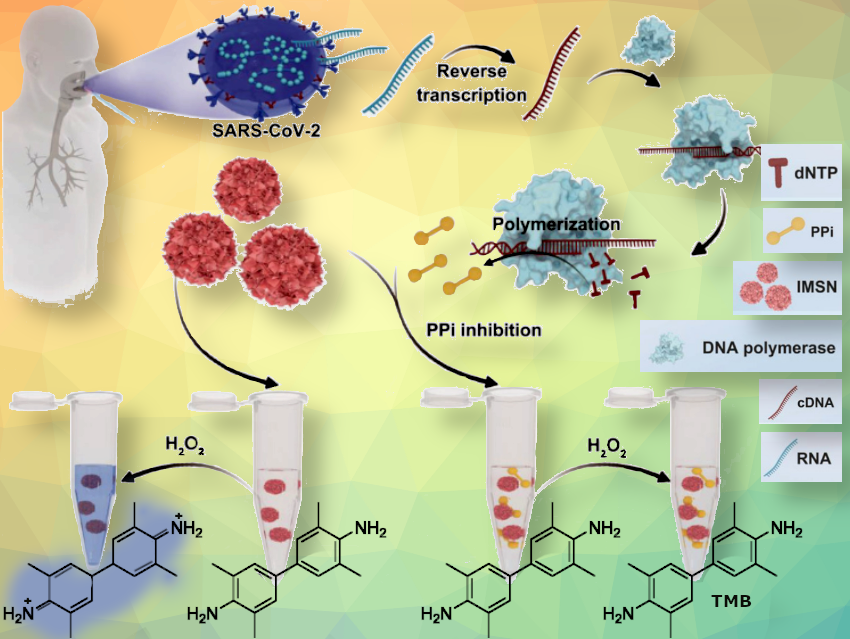Fluorescence-based PCR and other amplification methods have been used for SARS-CoV-2 diagnostics, however, it requires costly fluorescence detectors and probes limiting deploying large-scale screening. Xin Su and Huiyu Liu, Beijing University of Chemical Technology, China, and colleagues have designed a cut-price colorimetric method for SARS-CoV-2 RNA detection by iron manganese silicate nanozyme (IMSN).
IMSN was synthesized by adding MnCl2, FeSO4·7H2O, and NH4Cl to a dispersion of uniform dendritic mesoporous silica nanoparticles (DMSN) in water, followed by the addition of NH3·H2O and maintaining the reaction at 140 °C for 12 hours, and washing the resulting sample with distilled water and ethanol before drying overnight at 60 °C.
The detection of target nucleic acids (pictured above) is based on the fact that amplification generated pyrophosphate ions (PPi) significantly inhibit the peroxidase-like activity of IMSN. The chromogenic reaction of 3,3′,5,5′-tetramethylbenzidine (TMB) catalyzed by IMSN shows high sensitivity to PPi, with a detection limit of 205.47 nm and a dynamic range of 0.6–4.5 µm. Moreover, IMSN also shows high selectivity to PPi and does not respond to some analogs, such as deoxy-ribonucleoside triphosphate (dNTP) and phosphate. Due to the large number of PPi generated during nucleic acid amplification and the high sensitivity of IMSN to PPi, the detection limit of SARS-CoV-2 nucleic acid reaches 240 copies mL−1, which can be seen by the naked eye.
According to the researchers, this nanozyme-based method represents a new concept in cost-effective and simple nucleic acid testing which can facilitate COVID-19 point-of-care testing (POC) testing and large-scale screening.
- Nanozyme-Based Colorimetric SARS-CoV-2 Nucleic Acid Detection by Naked Eye,
Mengya He, Xican Xu, Hongyu Wang, Qingyuan Wu, Linghao Zhang, Dongsheng Zhou, Yigang Tong, Xin Su, Huiyu Liu,
Small 2023.
https://doi.org/10.1002/smll.202208167
Also of Interest
- ChemistryViews Collection:
SARS-CoV-2 Virus – What We Know About Vaccines and Immunity



